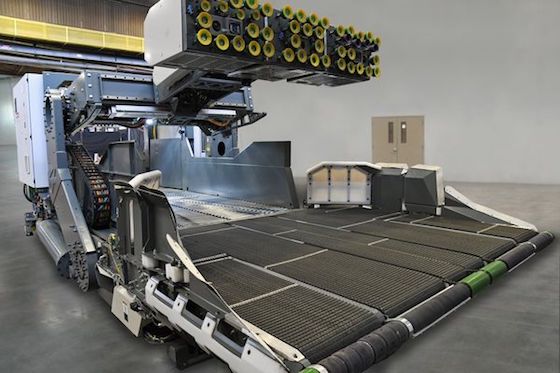Here’s a new robot the tech-whizzes have built that will further automate the Amazon-fueled mail-order economy — and eliminate jobs for humans. Apparently Fed-Ex and UPS are cranking up their services to keep up with the delivery business, and they think a truck unloader will be just the ticket to speed the process along.
The Honeywell company has offered up a robot that utilizes suction cups and conveyor belts to unload trucks — a tricky chore when the items are different sizes and shapes as they often are. Replacing human dexterity in a world of diverse objects is one of the toughest challenges for automation.
Below, on the Honeywell machine, the yellow circles are suction cups which lift items from the truck and drop them onto the conveyor belts below.

The thing has a rickety look, like non-sturdy items might be at risk of being damaged by such a crude machine.
But the robots will be cheaper than human workers which is the point of the technology. However it’s still unclear how the economic Masters of the Universe imagine how the coming automated economy can work when millions of willing shoppers cease getting paychecks — nevertheless business continues to plan replacement of humans with smart machines.
It’s no wonder that tech experts around the world forecast a highly automated future: Oxford researchers forecast in 2013 that nearly half of American jobs were vulnerable to machine or software replacement within 20 years. Rice University computer scientist Moshe Vardi believes that in 30 years humans will become largely obsolete, and world joblessness will reach 50 percent. The Gartner tech advising company believes that one-third of jobs will be done by machines by 2025. The consultancy firm PwC published a report last year that forecast robots could take 38 percent of US jobs by 2030. In November 2017, the McKinsey Global Institute reported that automation “could displace up to 800 million workers — 30 percent of the global workforce — by 2030.” Forrester Research estimates that robots and artificial intelligence could eliminate nearly 25 million jobs in the United States over the next decade, but it should create nearly 15 million positions, resulting in a loss of 10 million US jobs. Kai-Fu Lee, the venture capitalist and author of AI Superpowers: China, Silicon Valley, and the New World Order, forecast on CBS’ Sixty Minutes about automation and artificial intelligence: “in 15 years, that’s going to displace about 40 percent of the jobs in the world.” A February 2018 paper from Bain & Company, Labor 2030, predicted, “By the end of the 2020s, automation may eliminate 20% to 25% of current jobs.”
Given such basic economic changes, we won’t be needing any unskilled foreigners (like the thousands currently streaming across America’s open border) to be doing simple physical jobs like unloading trucks when machines become cheaper.
Rise of the warehouse robots: Honeywell and Siemens launch automated truck unloaders that use AI to ferry packages, Daily Mail, May 3, 2019
Robots are increasingly picking up the slack in package distribution centers.
Honeywell and Siemens have unveiled new machines that are capable of autonomously ferrying packages from the tractor trailer to the fulfillment center with surprising accuracy, according to Bloomberg.
It comes as consumers increasingly expect two-day or even same-day delivery, causing shipping companies to embrace automation as a solution to meet the spike in demand.
Both Honeywell and Siemens’ robot unloaders drive up to the back of a tractor trailer and use machine learning to identify packages.
And, the companies say their machines work just as fast, if not faster, than human employees.
For example, it takes Siemens’ robotic unloader about 10 minutes to empty a tractor trailer, whereas it would take one person up to an hour to move the boxes, according to Bloomberg.
Honeywell said its device is capable of unloading packages at a rate of 1,500 cases per hour.
Its machine works via an apparatus that extends into the back of the truck, scooping the packages up using a conveyor belt.
The machine then pulls them out and carries them into a distribution center.
Additionally, another apparatus is located at the top of the machine with suction cups attached, so as to be able to grab packages that are stacked up high inside the truck. (Continues)


